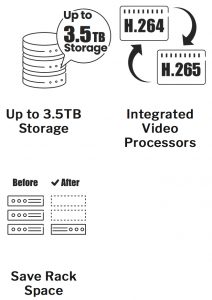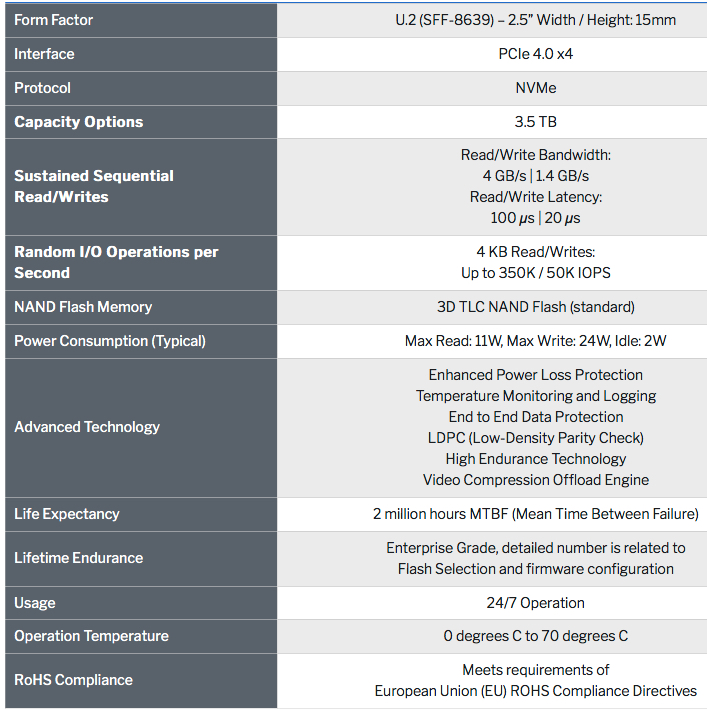FMS: Netint Technologies Reveals Codensity EdgeFusion to Improve Video Processing Economics at Network Edge
EdgeFusion E408 combines SSD storage with video transcoding in compact module to improve video storage, distribution and encoding economics.
This is a Press Release edited by StorageNewsletter.com on August 7, 2019 at 2:50 pmNETINT Technologies, in computational storage and video processing SoC solutions, announced Codensity EdgeFusion E408, combining its video processing expertise with their SSD technology into a single compact integrated solution suitable for deployment at the network edge.

With it, based on NETINT’s in-house developed Codensity G4 system on chip ASIC, video streaming providers, application developers, cloud data center operators, and edge networking companies can improve the economics for their video storage, processing, and distribution requirements.
According to a revent Cisco VNI report, IP video will be 82% of all IP traffic by 2022 while live Internet video will grow 15-fold from 2017-2022.
Video content, due to their large data file sizes and bandwidth requirements, will continue to be a growing challenge to store and process for video distributors. In parallel, cloud service providers and CDN operators are increasingly motivated to move video storage and processing closer to the network edge, to save core network bandwidth costs, improve QoE, while supporting emerging interactive cloud video application requirements such as cloud gaming, augmented reality (AR), and virtual reality (VR).
SSDs are used for caching IP video streaming content in edge locations to minimize network delays with end users. Meanwhile, video processing including compression, transcoding and encoding of video content to H.264 AVC or H.265 HEVC formats is frequently applied to reduce file sizes for economical distribution through the CDN.
Video processing is normally applied using software running on host servers, however this approach requires a deal of host hardware, rack space, and electrical power, which impacts scalability given the space and power limitations at edge data center locations.
Codensity EdgeFusion E408 is the fusion of video processor and SSD storage technologies into a single compact integrated solution for video application processing in cloud and edge architectures.
Its high-performance NVMe SSDs support 3.5TB of NAND flash persistent memory. With its PCIe 4.0 interface, it delivers up to 2x throughput compared to PCIe 3.0 SSDs, making it for fast storage and retrieval of large video files.
The Codensity EdgeFusion E408’s computational storage architecture combines its SSD capabilities with advanced H.264 AVC and H.265 HEVC video processors. This architecture enables it to also process 4K UHD video at 60 frames per second throughput, suitable for transcoding up to 8x 1080p30 video streams, or generating multiple encoding ladders at the edge for adaptive bit rate (ABR) streaming to video consumers. For video caching or storage requirements, the Codensity EdgeFusion E408’s video processors can compress H.264 video to H.265 format, saving up to 50% storage space inside the SSD.
It is available in an industry-standard PCIe U.2 or AIC form factor, and is controlled through a standard NVMe interface, supporting plug-in scalability using NVMe servers in edge locations.
Use cases and benefits of the EdgeFusion E408 include:
- Save Video Caching and Storage costs: video transcoding capabilities, video content can be stored in a compressed format, saving storage space and costs.
- Reduce Core Network Bandwidth and Costs: CDN and cloud operators can reduce distribution bandwidth and costs by sending only the original source video to edge locations, where the EdgeFusion E408 can economically generate encoding ladders at the edge.
- Optimize Surveillance Video Processing: The increasing adoption of cloud video surveillance generates significant internet traffic. With the Codensity EdgeFusion E408, surveillance video can be stored and transcoded at edge-located servers with minimized space and power, while reducing bandwidth OPEX costs for cloud surveillance applications.
- Deliver Cloud Gaming, AR, and VR Applications: Processing interactive video applications, especially VR/AR, will require very low network latency. The Codensity EdgeFusion E408 is a solution, supporting deterministic low latency encoding of each frame generated by third party cloud gaming and rendering applications running inside the edge gaming server.
“The explosive growth of internet video is driving the demand for advanced computational storage solutions,” said Tao Zhong, CEO, NETINT. “The Codensity EdgeFusion E408 is the fusion of our SSD storage and video transcoding capabilities in a small, low-power form factor, and is well aligned with the growing need to store and process video at the network edge.”
EdgeFusion E408 Preliminary Specs

To learn more about the Codensity EdgeFusion E408, visit NETINT Technologies at the upcoming flash Memory Summit from August 6-8 at the Santa Clara Convention Center.
About NETINT Technologies
It is in computational storage and video processing SoC solutions. Its Codensity portfolio enables cloud data centers, edge computing companies, and content providers to deploy scalable high-performance applications, while minimizing their storage and video processing costs. Founded by an experienced team of storage SoC veterans, is a Canadian venture-funded high-tech company with R&D facilities in Vancouver, Toronto, Canada and Shanghai, China.













 Subscribe to our free daily newsletter
Subscribe to our free daily newsletter

